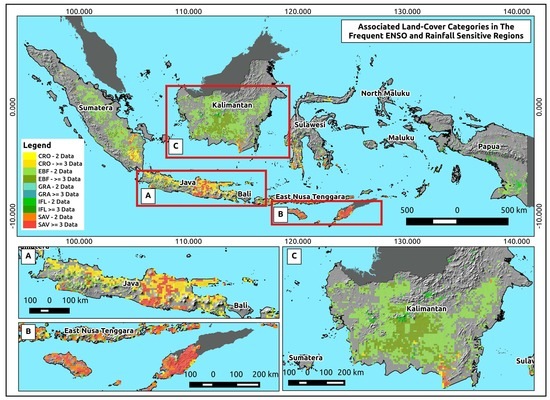ENSO- and Rainfall-Sensitive Vegetation Regions in Indonesia as Identified from Multi-Sensor Remote Sensing Data
Abstract
:1. Introduction
2. Study Area
3. Materials and Methods
3.1. Materials
3.1.1. Remote Sensing Based on Vegetation Proxies (RS Proxies)
3.1.2. Climate Data
3.1.3. Vegetation Cover Types
3.2. Methods
3.2.1. Bivariate Granger Causality
3.2.2. Cross-Correlation Function (CCF) from 0 to 12 Months
4. Results
4.1. Identified ENSO- and Rainfall-Sensitive Regions in Indonesia
4.2. Response of ENSO-Rainfall Sensitive Regions in Indonesia
5. Discussion
6. Conclusions
- Combinations of MEI (ENSO) and CHIRP-rainfall sensitive areas detected from Granger causality analysis frequently identified savanna, cropland, evergreen broadleaved forest, grassland, and remnant forest (IFL) as sensitive regions. The drastic phenology change of savanna, especially during drought and wet phases, created the strong relationship between ENSO and savanna environments, which was captured by various remote sensing-based vegetation proxies.
- The temporal graphs from the CCF analysis revealed that MEI (ENSO) affected the CHIRPS-rainfall values in the first months for which its variation further affected the values of RS proxies.
- The spatial distribution of time lag coefficients from CCF suggested that not only land cover types, but also topography, played an essential role in generating the spatial patterns.
Acknowledgments
Author Contributions
Conflicts of Interest
References
- Intergovernmental Panel on Climate Change (IPCC). Climate Change 2014–Impacts, Adaptation and Vulnerability: Regional Aspects; Cambridge University Press: Cambridge, UK, 2014. [Google Scholar]
- Sheffield, J.; Wood, E.F. Projected changes in drought occurrence under future global warming from multi-model, multi-scenario, IPCC ar4 simulations. Clim. Dyn. 2008, 31, 79–105. [Google Scholar] [CrossRef]
- Collins, M.; An, S.-I.; Cai, W.; Ganachaud, A.; Guilyardi, E.; Jin, F.-F.; Jochum, M.; Lengaigne, M.; Power, S.; Timmermann, A. The impact of global warming on the tropical Pacific Ocean and El niño. Nat. Geosci. 2010, 3, 391–397. [Google Scholar] [CrossRef]
- Cai, W.; Santoso, A.; Wang, G.; Yeh, S.-W.; An, S.-I.; Cobb, K.M.; Collins, M.; Guilyardi, E.; Jin, F.-F.; Kug, J.-S. Enso and greenhouse warming. Nat. Clim. Chang. 2015, 5, 849–859. [Google Scholar] [CrossRef] [Green Version]
- Kirono, D.G.; Tapper, N.J.; McBride, J.L. Documenting indonesian rainfall in the 1997/1998 El nino event. Phys. Geogr. 1999, 20, 422–435. [Google Scholar]
- Arcari, P.; Tapper, N.; Pfueller, S. Regional variability in relationships between climate and dengue/DHF in indonesia. Singap. J. Trop. Geogr. 2007, 28, 251–272. [Google Scholar] [CrossRef]
- Murdiyarso, D.; Adiningsih, E.S. Climate anomalies, indonesian vegetation fires and terrestrial carbon emissions. Mitig. Adapt. Strateg. Glob. Chang. 2007, 12, 101–112. [Google Scholar] [CrossRef]
- Boisvenue, C.; Running, S.W. Impacts of climate change on natural forest productivity–evidence since the middle of the 20th century. Glob. Chang. Biol. 2006, 12, 862–882. [Google Scholar] [CrossRef]
- Allen, C.D.; Macalady, A.K.; Chenchouni, H.; Bachelet, D.; McDowell, N.; Vennetier, M.; Kitzberger, T.; Rigling, A.; Breshears, D.D.; Hogg, E.T. A global overview of drought and heat-induced tree mortality reveals emerging climate change risks for forests. For. Ecol. Manag. 2010, 259, 660–684. [Google Scholar] [CrossRef]
- Holmgren, M.; Scheffer, M.; Ezcurra, E.; Gutiérrez, J.R.; Mohren, G.M. El niño effects on the dynamics of terrestrial ecosystems. Trends Ecol. Evol. 2001, 16, 89–94. [Google Scholar] [CrossRef]
- Kirono, D.G.; Tapper, N.J. Enso rainfall variability and impacts on crop production in indonesia. Phys. Geogr. 1999, 20, 508–519. [Google Scholar]
- Naylor, R.L.; Falcon, W.P.; Rochberg, D.; Wada, N. Using El Nino/Southern Oscillation climate data to predict rice production in indonesia. Clim. Chang. 2001, 50, 255–265. [Google Scholar] [CrossRef]
- Naylor, R.L.; Battisti, D.S.; Vimont, D.J.; Falcon, W.P.; Burke, M.B. Assessing risks of climate variability and climate change for indonesian rice agriculture. Proc. Natl. Acad. Sci. USA 2007, 104, 7752–7757. [Google Scholar] [CrossRef] [PubMed]
- Gutman, G.; Csiszar, I.; Romanov, P. Using NOAA/AVHRR products to monitor El Nino impacts: Focus on Indonesia in 1997–1998. Bull. Am. Meteorol. Soc. 2000, 81, 1189–1205. [Google Scholar] [CrossRef]
- Erasmi, S.; Propastin, P.; Kappas, M.; Panferov, O. Spatial patterns of NDVI variation over Indonesia and their relationship to ENSO warm events during the period 1982–2006. J. Clim. 2009, 22, 6612–6623. [Google Scholar] [CrossRef]
- Tucker, C.; Sellers, P. Satellite remote sensing of primary production. Int. J. Remote Sens. 1986, 7, 1395–1416. [Google Scholar] [CrossRef]
- Pinzon, J.E.; Tucker, C.J. A non-stationary 1981–2012 AVHRR NDVI3g time series. Remote Sens. 2014, 6, 6929–6960. [Google Scholar] [CrossRef]
- Hawinkel, P.; Thiery, W.; Lhermitte, S.; Swinnen, E.; Verbist, B.; Van Orshoven, J.; Muys, B. Vegetation response to precipitation variability in East Africa controlled by biogeographical factors. J. Geophys. Res. Biogeosci. 2016, 121, 2422–2444. [Google Scholar] [CrossRef]
- Piao, S.; Fang, J.; Zhou, L.; Ciais, P.; Zhu, B. Variations in satellite-derived phenology in china’s temperate vegetation. Glob. Chang. Biol. 2006, 12, 672–685. [Google Scholar] [CrossRef]
- Revadekar, J.; Tiwari, Y.K.; Kumar, K.R. Impact of climate variability on NDVI over the Indian region during 1981–2010. Int. J. Remote Sens. 2012, 33, 7132–7150. [Google Scholar] [CrossRef]
- Epiphanio, J.N.; Huete, A.R. Dependence of NDVI and SAVI on sun/sensor geometry and its effect on fAPAR relationships in Alfalfa. Remote Sens. Environ. 1995, 51, 351–360. [Google Scholar] [CrossRef]
- Huete, A.; Didan, K.; Miura, T.; Rodriguez, E.P.; Gao, X.; Ferreira, L.G. Overview of the radiometric and biophysical performance of the modis vegetation indices. Remote Sens. Environ. 2002, 83, 195–213. [Google Scholar] [CrossRef]
- Rocha, A.V.; Shaver, G.R. Advantages of a two band EVI calculated from solar and photosynthetically active radiation fluxes. Agric. For. Meteorol. 2009, 149, 1560–1563. [Google Scholar] [CrossRef]
- Jiang, Z.; Huete, A.R.; Didan, K.; Miura, T. Development of a two-band enhanced vegetation index without a blue band. Remote Sens. Environ. 2008, 112, 3833–3845. [Google Scholar] [CrossRef]
- Pettorelli, N.; Vik, J.O.; Mysterud, A.; Gaillard, J.-M.; Tucker, C.J.; Stenseth, N.C. Using the satellite-derived NDVI to assess ecological responses to environmental change. Trends Ecol. Evol. 2005, 20, 503–510. [Google Scholar] [CrossRef] [PubMed]
- Owe, M.; de Jeu, R.; Walker, J. A methodology for surface soil moisture and vegetation optical depth retrieval using the microwave polarization difference index. IEEE Trans. Geosci. Remote Sens. 2001, 39, 1643–1654. [Google Scholar] [CrossRef]
- Liu, Y.Y.; Dijk, A.I.; McCabe, M.F.; Evans, J.P.; Jeu, R.A. Global vegetation biomass change (1988–2008) and attribution to environmental and human drivers. Glob. Ecol. Biogeogr. 2013, 22, 692–705. [Google Scholar] [CrossRef]
- Liu, Y.Y.; de Jeu, R.A.; McCabe, M.F.; Evans, J.P.; van Dijk, A.I. Global long-term passive microwave satellite-based retrievals of vegetation optical depth. Geophys. Res. Lett. 2011, 38. [Google Scholar] [CrossRef]
- Amien, I.; Rejekiningrum, P.; Pramudia, A.; Susanti, E. Effects of Interannual climate variability and climate change on rice yield in Java, Indonesia. In Climate Change Vulnerability and Adaptation in Asia and the Pacific; Springer: Beilin, Germany, 1996; pp. 29–39. [Google Scholar]
- MacDicken, K.; Jonsson, Ö.; Piña, L.; Maulo, S.; Contessa, V.; Adikari, Y.; Garzuglia, M.; Lindquist, E.; Reams, G.; D’Annunzio, R. Global Forest Resources Assessment 2015: How Are the World’s Forests Changing? Food and Agriculture Organization: Rome, Italy, 2016. [Google Scholar]
- EcoCast. Available online: https://ecocast.arc.nasa.gov/data/pub/gimms/ (accessed on 13 January 2017).
- Jönsson, P.; Eklundh, L. Timesat—A program for analyzing time-series of satellite sensor data. Comput. Geosci. 2004, 30, 833–845. [Google Scholar] [CrossRef]
- Didan, K.; Munoz, A.B.; Solano, R.; Huete, A. MODIS vegetation index user’s guide (MOD13 series). Available online: https://icdc.cen.uni-hamburg.de/fileadmin/user_upload/icdc_Dokumente/MODIS/MODIS_Collection6_VegetationIndex_UsersGuide_MOD13_V03_June2015.pdf (accessed on 14 March 2018).
- Jiang, Z.; Huete, A.R.; Kim, Y.; Didan, K. 2-band enhanced vegetation index without a blue band and its application to AVHRR data. Proc. SPIE 2007, 6679, 667905. [Google Scholar] [CrossRef]
- Meesters, A.G.; De Jeu, R.A.; Owe, M. Analytical derivation of the vegetation optical depth from the microwave polarization difference index. IEEE Geosci. Remote Sens. Lett. 2005, 2, 121–123. [Google Scholar] [CrossRef]
- Owe, M.; de Jeu, R.; Holmes, T. Multisensor historical climatology of satellite-derived global land surface moisture. J. Geophys. Res. Earth Surf. 2008, 113. [Google Scholar] [CrossRef] [Green Version]
- Liu, Y.Y.; Van Dijk, A.I.; De Jeu, R.A.; Canadell, J.G.; McCabe, M.F.; Evans, J.P.; Wang, G. Recent reversal in loss of global terrestrial biomass. Nat. Clim. Chang. 2015, 5, 470–474. [Google Scholar] [CrossRef]
- Flemish Institute for Technological Research (VITO). Available online: http://www.vito-eodata.be (accessed on 4 April 2017).
- Wolters, E.; Swinnen, E.; Toté, C.; Sterckx, S. Spot-VGT Collection 3 Products User Manual; Flemish Institute for Technological Research (VITO): Antwerp, Belgium, 2016. [Google Scholar]
- Huete, A.; Justice, C.; Van Leeuwen, W. MODIS vegetation index (MOD13). Algorithm Theor. Basis Doc. 1999, 3, 213. [Google Scholar]
- Stenseth, N.C.; Ottersen, G.; Hurrell, J.W.; Mysterud, A.; Lima, M.; Chan, K.S.; Yoccoz, N.G.; Ådlandsvik, B. Studying climate effects on ecology through the use of climate indices: The North Atlantic Oscillation, El Nino Southern Oscillation and beyond. Proc. R. Soc. Lond. B Biol. Sci. 2003, 270, 2087–2096. [Google Scholar] [CrossRef] [PubMed]
- Wolter, K. Mei Index (Current Update: 9 November 2017). Available online: https://www.esrl.noaa.gov/psd/enso/mei/table.html (accessed on 20 November 2017).
- Chirps. Available online: http://chg.geog.ucsb.edu/data/chirps/ (accessed on 4 January 2017).
- Funk, C.; Peterson, P.; Landsfeld, M.; Pedreros, D.; Verdin, J.; Shukla, S.; Husak, G.; Rowland, J.; Harrison, L.; Hoell, A. The climate hazards infrared precipitation with stations—A new environmental record for monitoring extremes. Sci. Data 2015, 2, 150066. [Google Scholar] [CrossRef] [PubMed]
- Katsanos, D.; Retalis, A.; Michaelides, S. Validation of a high-resolution precipitation database (CHIRPS) over Cyprus for a 30-year period. Atmos. Res. 2016, 169, 459–464. [Google Scholar] [CrossRef]
- Trejo, F.J.P.; Barbosa, H.A.; Peñaloza-Murillo, M.A.; Moreno, M.A.; Farías, A. Intercomparison of improved satellite rainfall estimation with chirps gridded product and rain gauge data over venezuela. Atmósfera 2016, 29, 323–342. [Google Scholar] [CrossRef]
- Friedl, M.A.; Sulla-Menashe, D.; Tan, B.; Schneider, A.; Ramankutty, N.; Sibley, A.; Huang, X. Modis collection 5 global land cover: Algorithm refinements and characterization of new datasets. Remote Sens. Environ. 2010, 114, 168–182. [Google Scholar] [CrossRef]
- Potapov, P.; Yaroshenko, A.; Turubanova, S.; Dubinin, M.; Laestadius, L.; Thies, C.; Aksenov, D.; Egorov, A.; Yesipova, Y.; Glushkov, I. Mapping the world’s intact forest landscapes by remote sensing. Ecol. Soc. 2008, 13, 51. [Google Scholar] [CrossRef]
- Russell-Smith, J.; Djoeroemana, S.; Maan, J.; Pandanga, P. Rural livelihoods and burning practices in savanna landscapes of nusa tenggara timur, eastern indonesia. Hum. Ecol. 2007, 35, 345–359. [Google Scholar] [CrossRef]
- Hothorn, T.; Zeileis, A.; Farebrother, R.W.; Cummins, C.; Millo, G.; Mitchell, D. Lmtest: Testing Linear Regression Models. R Package Version 0.9-34. Available online: https://cran.r-project.org/package=lmtest (accessed on 6 May 2017).
- Granger, C.W. Investigating causal relations by econometric models and cross-spectral methods. Econom. J. Econom. Soc. 1969, 37, 424–438. [Google Scholar] [CrossRef]
- Eichler, M. Causal inference in time series analysis. Causal. Stat. Perspect. Appl. 2012, 327–354. [Google Scholar] [CrossRef]
- Aldrian, E.; Dwi Susanto, R. Identification of three dominant rainfall regions within indonesia and their relationship to sea surface temperature. Int. J. Climatol. 2003, 23, 1435–1452. [Google Scholar] [CrossRef]
- Aldrian, E.; Gates, L.D.; Widodo, F. Seasonal variability of indonesian rainfall in ECHAM4 simulations and in the reanalyses: The role of ENSO. Theor. Appl. Climatol. 2007, 87, 41–59. [Google Scholar] [CrossRef]
- Aldrian, E.; Djamil, Y.S. Spatio-temporal climatic change of rainfall in east Java Indonesia. Int. J. Climatol. 2008, 28, 435–448. [Google Scholar] [CrossRef]
- Ji, L.; Peters, A.J. Assessing vegetation response to drought in the northern great plains using vegetation and drought indices. Remote Sens. Environ. 2003, 87, 85–98. [Google Scholar] [CrossRef]
- Fensham, R.; Holman, J. Temporal and spatial patterns in drought-related tree dieback in Australian savanna. J. Appl. Ecol. 1999, 36, 1035–1050. [Google Scholar] [CrossRef]
- Van Langevelde, F.; Van De Vijver, C.A.; Kumar, L.; Van De Koppel, J.; De Ridder, N.; Van Andel, J.; Skidmore, A.K.; Hearne, J.W.; Stroosnijder, L.; Bond, W.J. Effects of fire and herbivory on the stability of savanna ecosystems. Ecology 2003, 84, 337–350. [Google Scholar] [CrossRef]
- Fensham, R.; Fairfax, R.; Archer, S. Rainfall, land use and woody vegetation cover change in semi-arid Australian savanna. J. Ecol. 2005, 93, 596–606. [Google Scholar] [CrossRef]
- Staver, A.C.; Archibald, S.; Levin, S.A. The global extent and determinants of savanna and forest as alternative biome states. Science 2011, 334, 230–232. [Google Scholar] [CrossRef] [PubMed]
- Verbesselt, J.; Umlauf, N.; Hirota, M.; Holmgren, M.; Van Nes, E.H.; Herold, M.; Zeileis, A.; Scheffer, M. Remotely sensed resilience of tropical forests. Nat. Clim. Chang. 2016. [Google Scholar] [CrossRef]
- Hendon, H.H. Indonesian rainfall variability: Impacts of ENSO and local air–sea interaction. J. Clim. 2003, 16, 1775–1790. [Google Scholar] [CrossRef]
- Qian, J.-H.; Robertson, A.W.; Moron, V. Interactions among ENSO, the monsoon, and diurnal cycle in rainfall variability over Java, Indonesia. J. Atmos. Sci. 2010, 67, 3509–3524. [Google Scholar] [CrossRef]
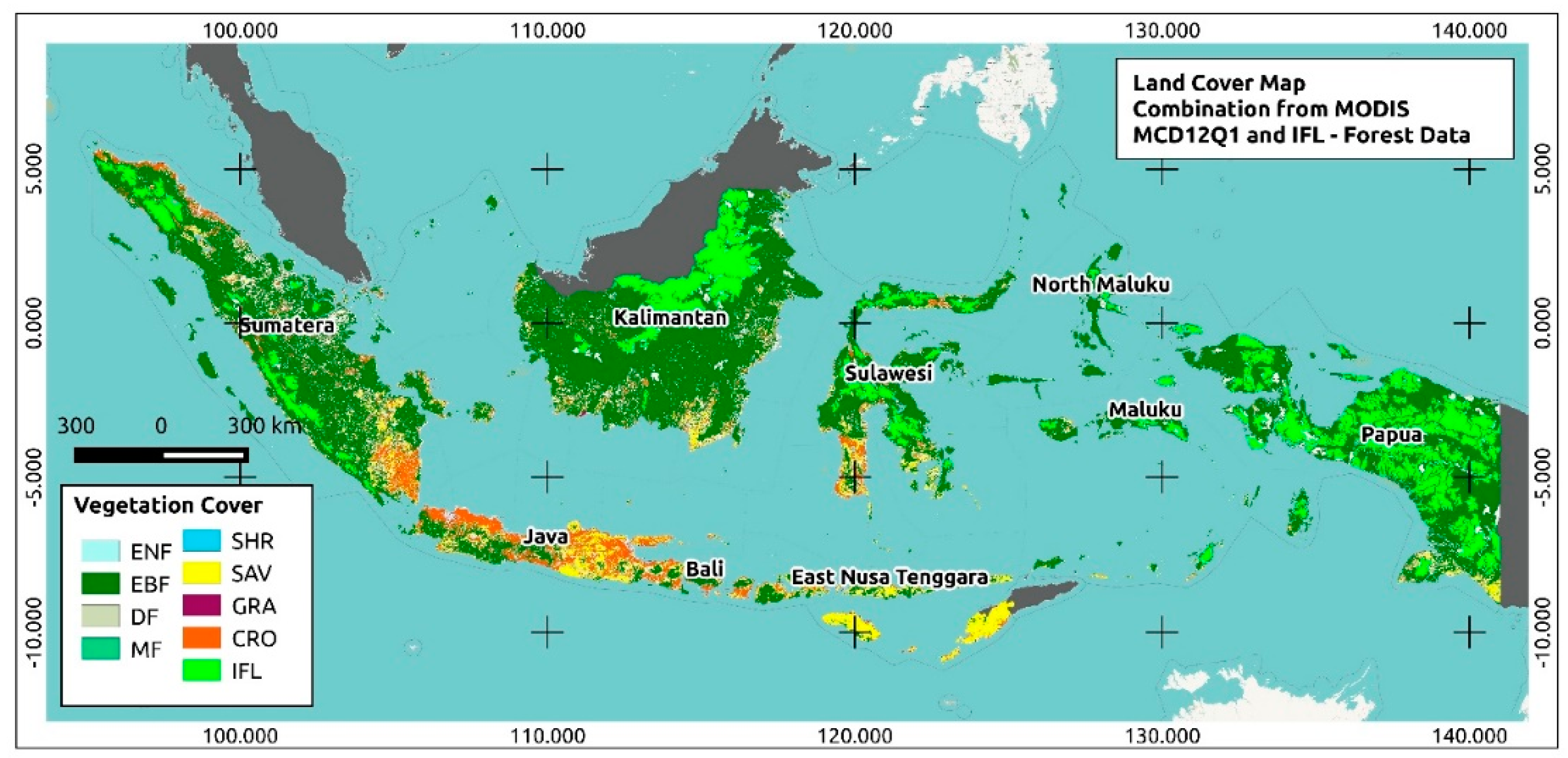

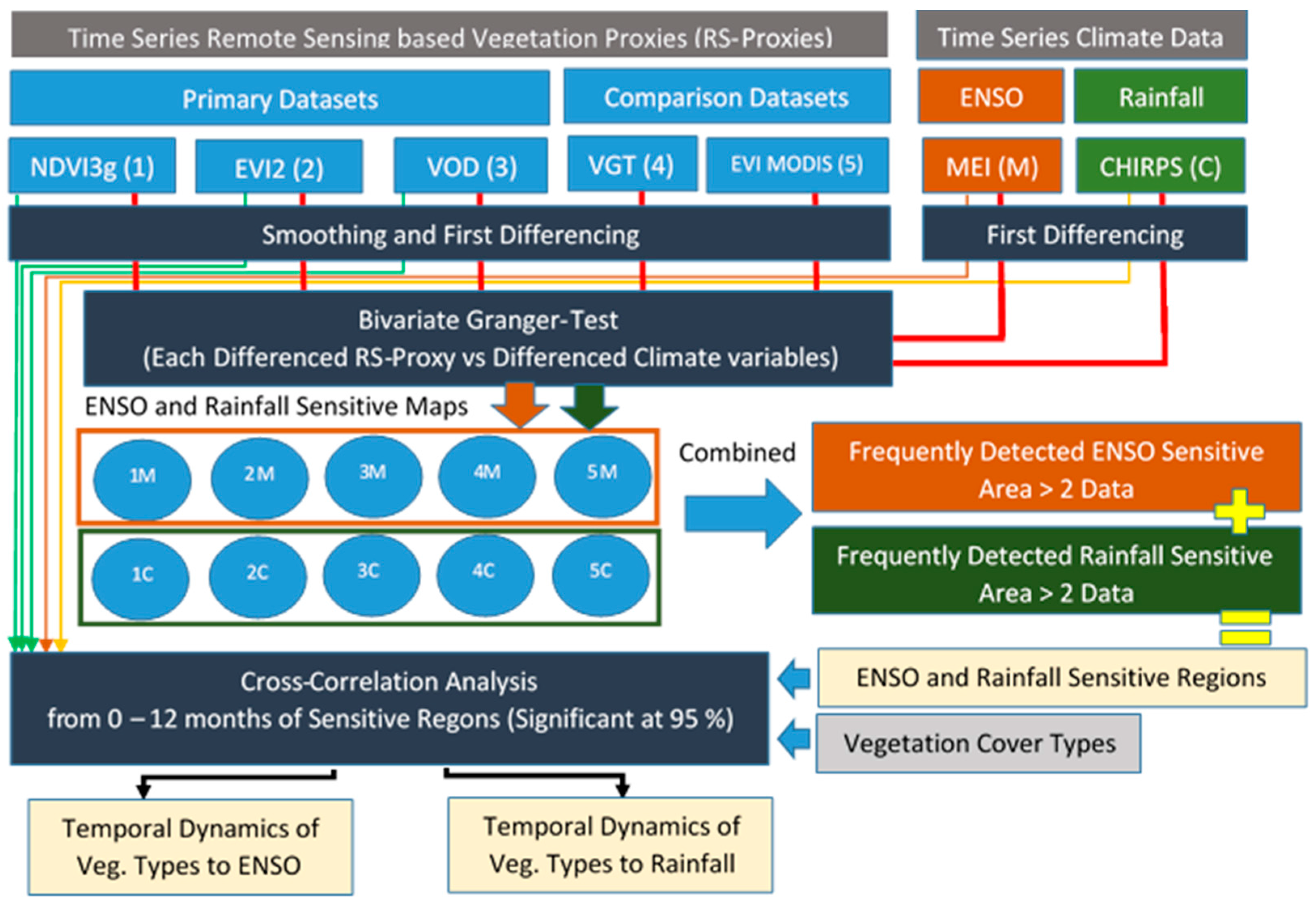
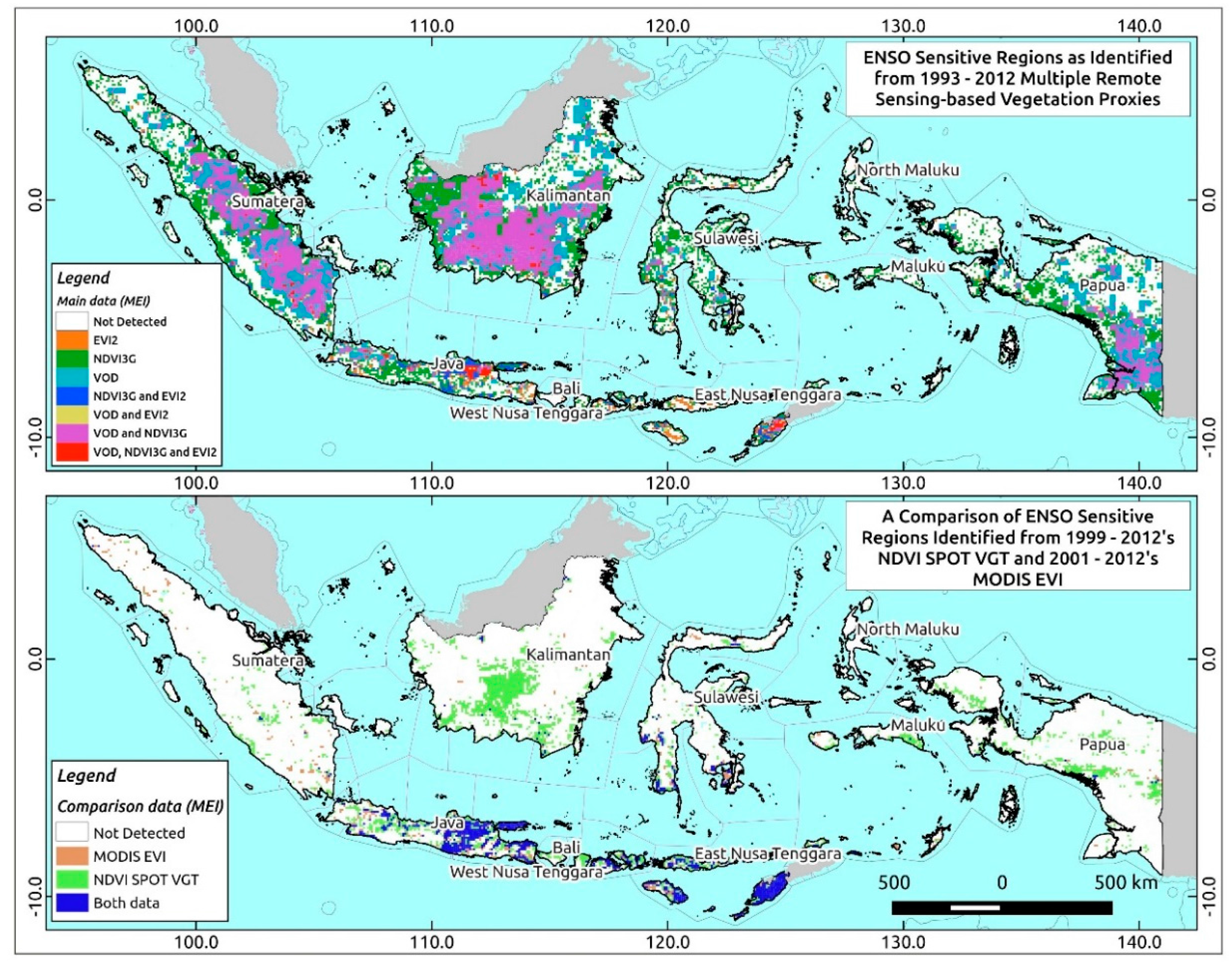

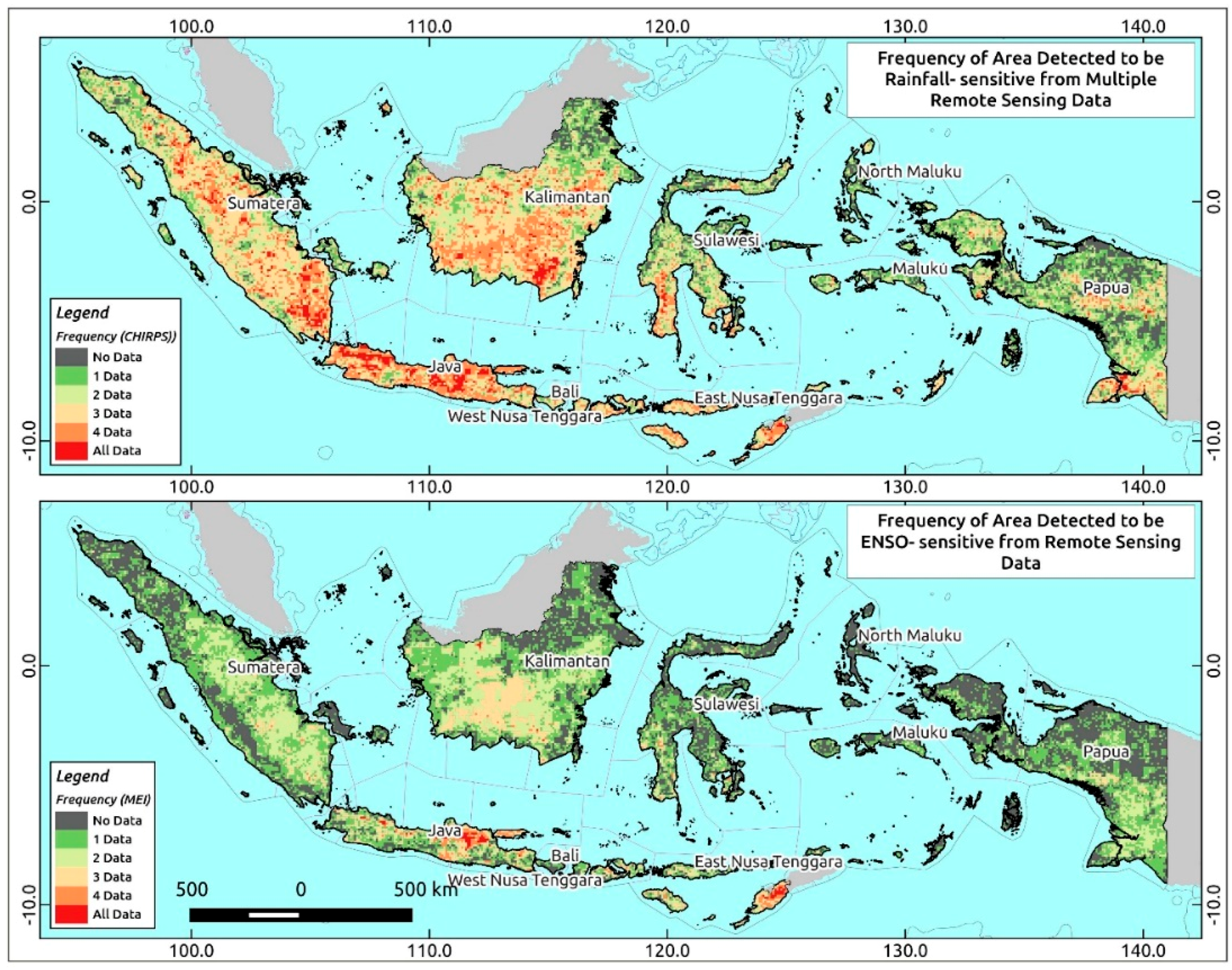
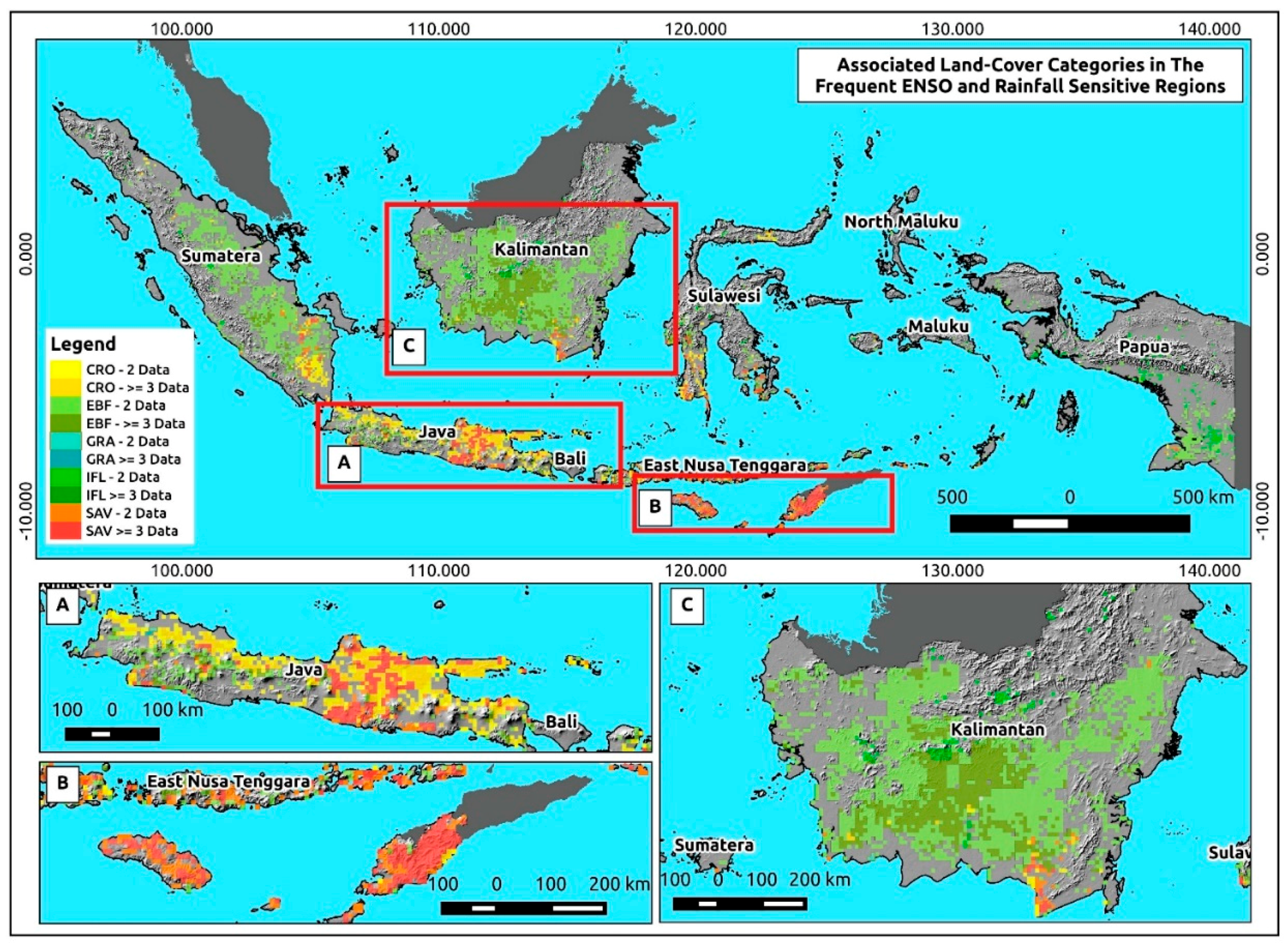
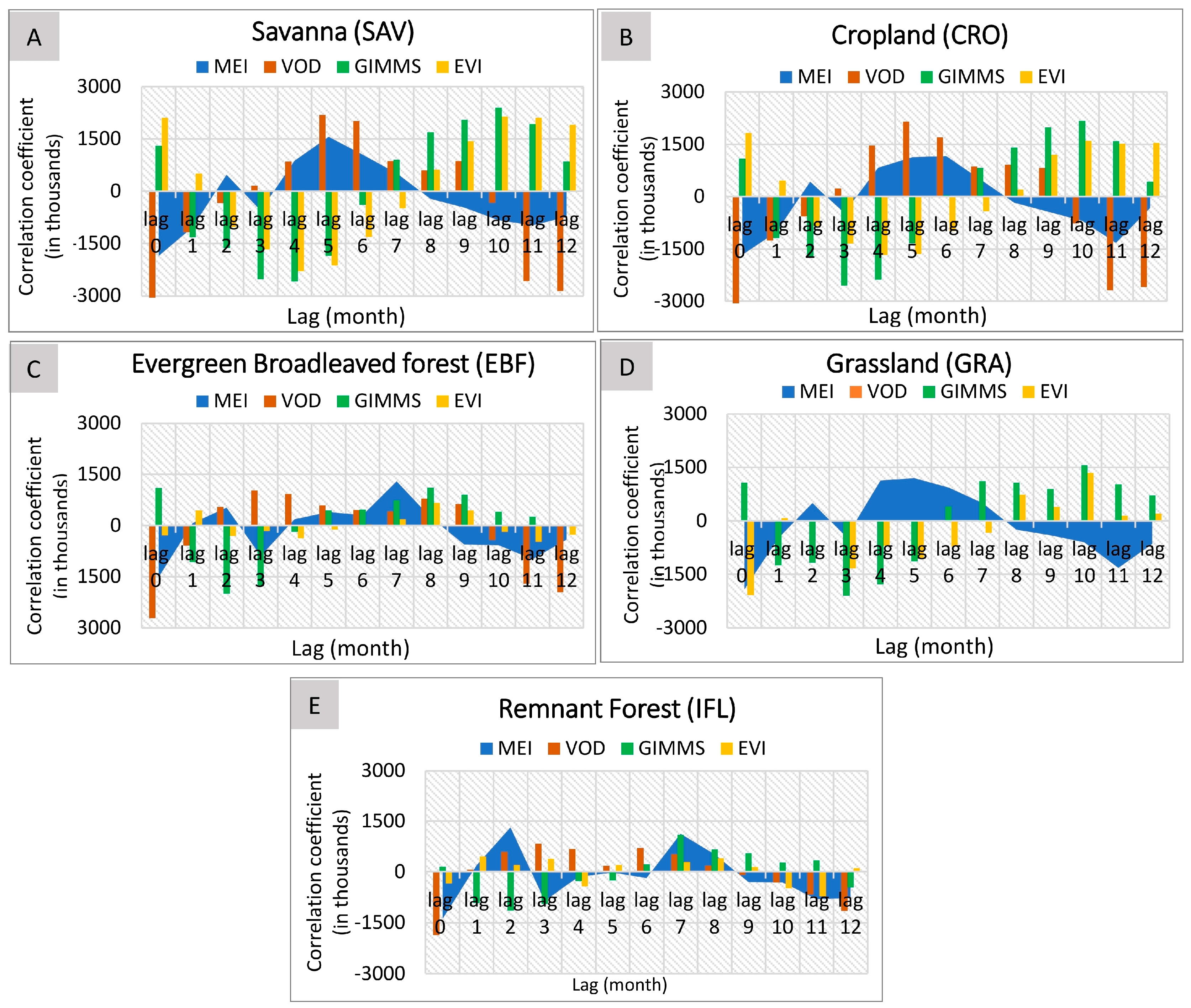
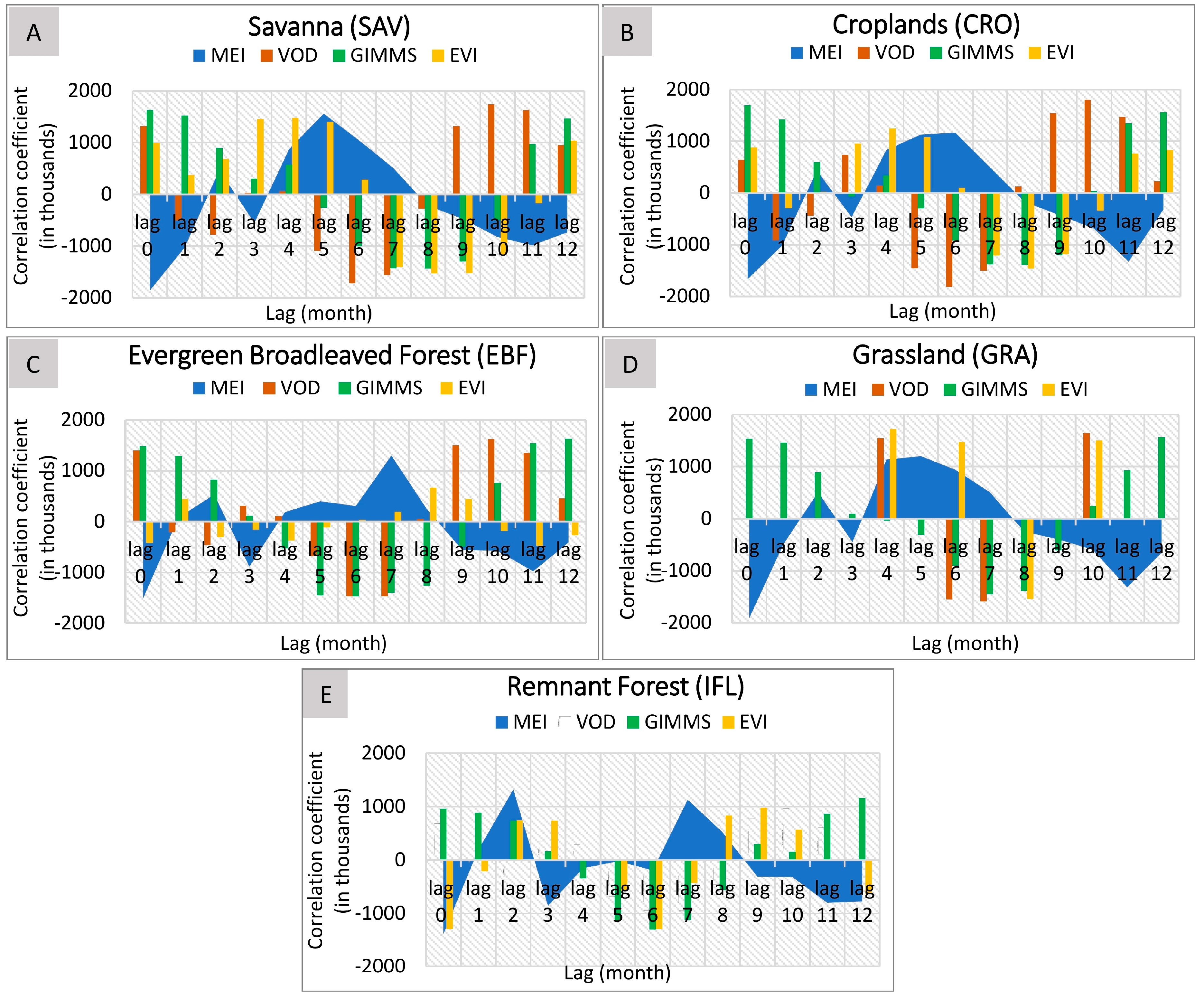
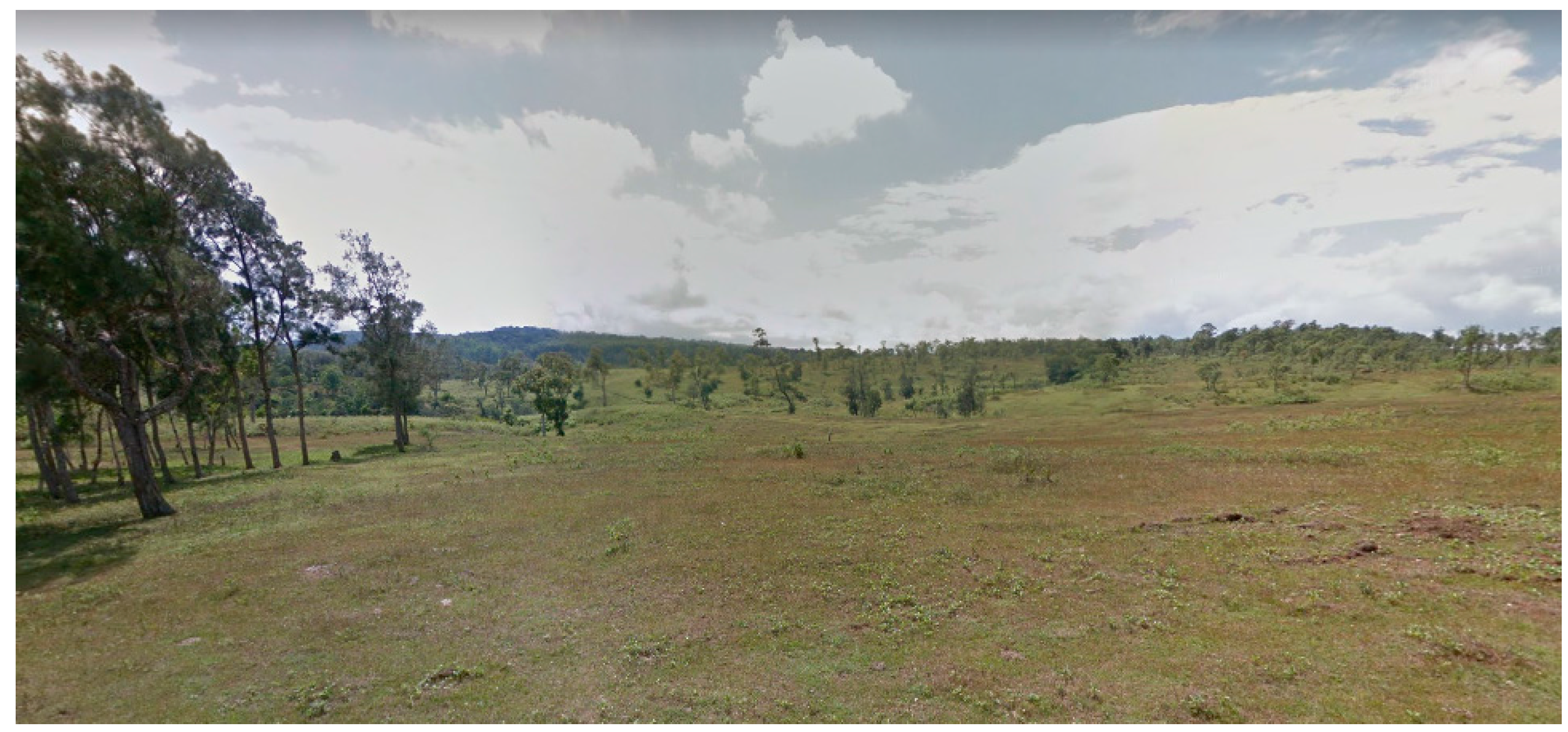
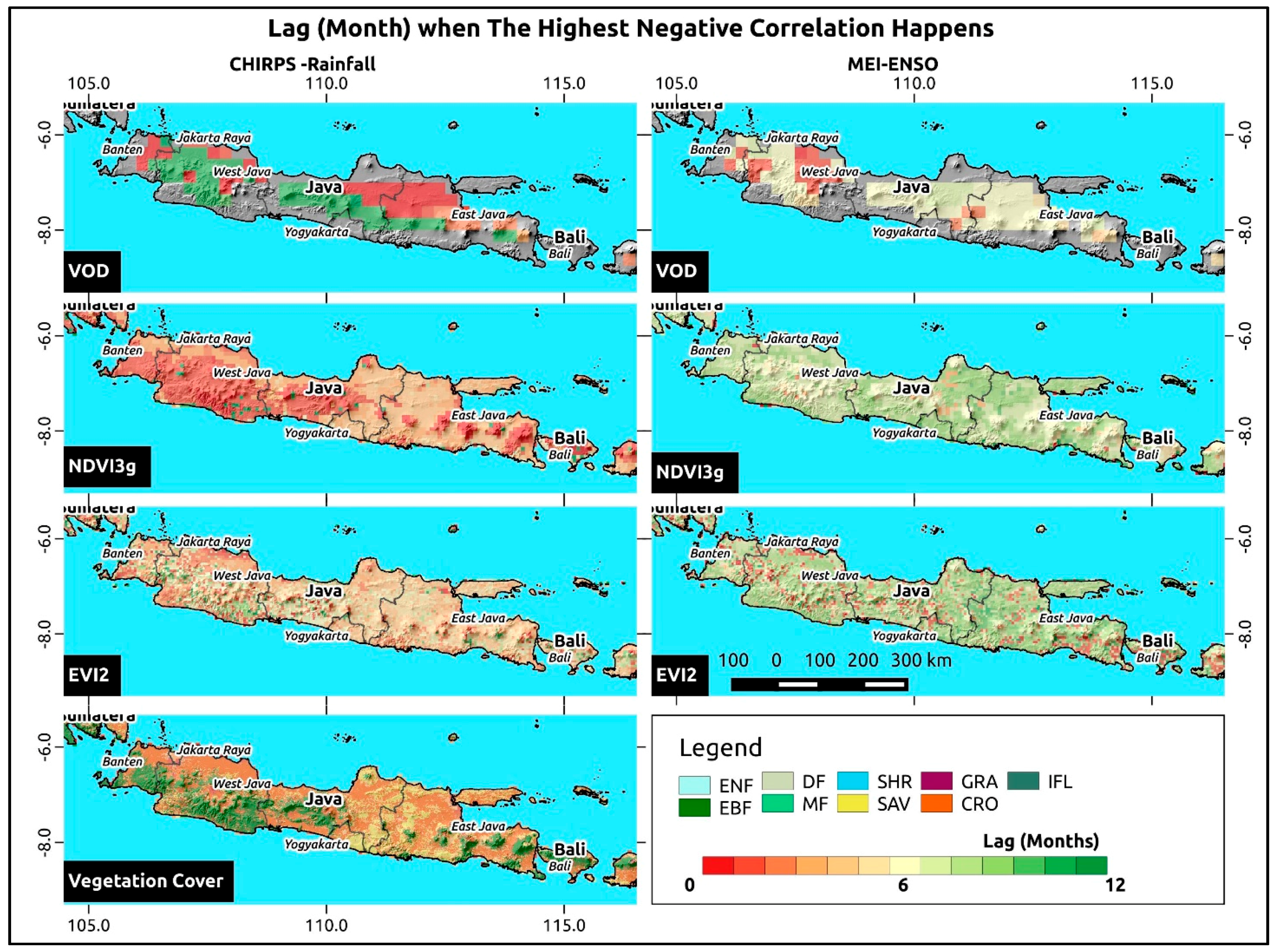
| No. | Categories | Code | Area (km2) | (%) |
|---|---|---|---|---|
| 1. | Evergreen needleleaf forest | ENF | 1037.6 | 0.06 |
| 2. | Evergreen broadleaf forest | EBF | 1,281,219.2 | 69.29 |
| 3. | Deciduous forest | DF | 241.8 | 0.01 |
| 4. | Mixed forest | MF | 2204.2 | 0.12 |
| 5. | Shrublands | SHR | 312.7 | 0.02 |
| 6. | Savannas | SAV | 108,298.5 | 5.86 |
| 7. | Grasslands | GRA | 1889 | 0.10 |
| 8. | Croplands | CRO | 125,250.1 | 6.77 |
| 9. | IFL-Forest | IFL | 328,573 | 17.77 |
| MEI (ENSO) | |||||||||
| Class | Area 1 Data (Km2) | (%) | Area 2 Data (Km2) | (%) | Area ≥ 3 Data (Km2) | (%) | Non Sensitive (Km2) | (%) | Total Area |
| CRO | 38,926.84 | 21.8 | 36,433.4 | 20.4 | 30,860.29 | 17.34 | 71,754.55 | 40.32 | 177,975.09 |
| EBF | 499,465.8 | 31.9 | 353,837.2 | 2.6 | 77,308.29 | 4.94 | 633,039.8 | 40.48 | 1,563,651.2 |
| GRA | 172.74 | 5.8 | 431.66 | 14.6 | 346.96 | 11.76 | 1997.97 | 67.74 | 2949.34 |
| IFL | 131,764.5 | 36.0 | 40,232.7 | 11.0 | 5261.19 | 1.44 | 188,298.6 | 51.51 | 365,557.19 |
| SAV | 26,010.7 | 25.3 | 31,061.8 | 30.2 | 42,419.65 | 41.27 | 3295.52 | 3.21 | 102,787.74 |
| CHIRPS (Rainfall) | |||||||||
| Class | Area 1 Data (Km2) | (%) | Area 2 Data (Km2) | (%) | Area ≥ 3 Data (Km2) | (%) | Non Sensitive (Km2) | (%) | Total Area |
| CRO | 44,280.25 | 14.9 | 53,216.88 | 17.93 | 126,590.8 | 42.64 | 72,791.18 | 24.52 | 296,879.30 |
| EBF | 679,266.8 | 25.0 | 656,356.98 | 24.22 | 677,492.4 | 25.00 | 697,097.7 | 25.72 | 2,710,214.0 |
| GRA | 172.74 | 0.70 | 604.29 | 2.44 | 952.78 | 3.85 | 23,021.40 | 93.01 | 24,751.20 |
| IFL | 199,875.9 | 31.3 | 130,139.68 | 20.38 | 92,682.93 | 14.51 | 215,976.4 | 33.82 | 638,675.04 |
| SAV | 29,487.17 | 13.2 | 43,295.14 | 19.44 | 115,640.3 | 51.93 | 34,276.89 | 15.39 | 222,699.54 |
| Class | Area Detected by 2 Proxies (Km2) | % | Area Detected by > 2 Proxies (Km2) | % | Non Sensitive Area (Km2) | % | Total Area (Km2) |
|---|---|---|---|---|---|---|---|
| IFL | 25,131.17 | 6.89 | 1539.82 | 0.42 | 338,332.13 | 92.69 | 365,003.12 |
| SAV | 32,672.10 | 24.94 | 37,212.03 | 28.41 | 1539.82 | 2.16 | 71,423.96 |
| EBF | 316,591.08 | 19.74 | 65,998.74 | 4.11 | 25,131.17 | 6.16 | 407,720.99 |
| CRO | 37,574.32 | 21.20 | 27,552.54 | 15.55 | 1118.61 | 1.69 | 66,245.46 |
| GRA | 428.79 | 14.63 | 344.68 | 11.76 | 32,672.10 | 97.69 | 33,445.57 |
© 2018 by the authors. Licensee MDPI, Basel, Switzerland. This article is an open access article distributed under the terms and conditions of the Creative Commons Attribution (CC BY) license (http://creativecommons.org/licenses/by/4.0/).
Share and Cite
Arjasakusuma, S.; Yamaguchi, Y.; Hirano, Y.; Zhou, X. ENSO- and Rainfall-Sensitive Vegetation Regions in Indonesia as Identified from Multi-Sensor Remote Sensing Data. ISPRS Int. J. Geo-Inf. 2018, 7, 103. https://doi.org/10.3390/ijgi7030103
Arjasakusuma S, Yamaguchi Y, Hirano Y, Zhou X. ENSO- and Rainfall-Sensitive Vegetation Regions in Indonesia as Identified from Multi-Sensor Remote Sensing Data. ISPRS International Journal of Geo-Information. 2018; 7(3):103. https://doi.org/10.3390/ijgi7030103
Chicago/Turabian StyleArjasakusuma, Sanjiwana, Yasushi Yamaguchi, Yasuhiro Hirano, and Xiang Zhou. 2018. "ENSO- and Rainfall-Sensitive Vegetation Regions in Indonesia as Identified from Multi-Sensor Remote Sensing Data" ISPRS International Journal of Geo-Information 7, no. 3: 103. https://doi.org/10.3390/ijgi7030103




